Leading and Managing Change: Tesco's White Water Metaphor Analysis
VerifiedAdded on 2020/10/22
|12
|3771
|200
Report
AI Summary
This report provides a comprehensive analysis of change management within Tesco, focusing on the application of the white water metaphor. It begins by defining change management and contrasting the white water metaphor with the calm water metaphor, highlighting the benefits of the white water approach in a competitive business environment. The report then examines evidence of the white water metaphor in Tesco's operations, emphasizing its continuous monitoring of changes and proactive adaptation strategies, including planned and unplanned approaches. Furthermore, it evaluates the transformation from the calm water to the white water metaphor in relation to external business factors such as customers, technology, social, political, economic, and globalization-related factors, as well as business strategies like human resource management and competitive strategies. Finally, the report explores the implications of the white water shift on the human resource department, including strategic approaches for managing the shift, emphasizing the importance of continuous skill development and adaptation to maintain competitiveness. The report concludes by summarizing the key findings and insights regarding Tesco's change management strategies.
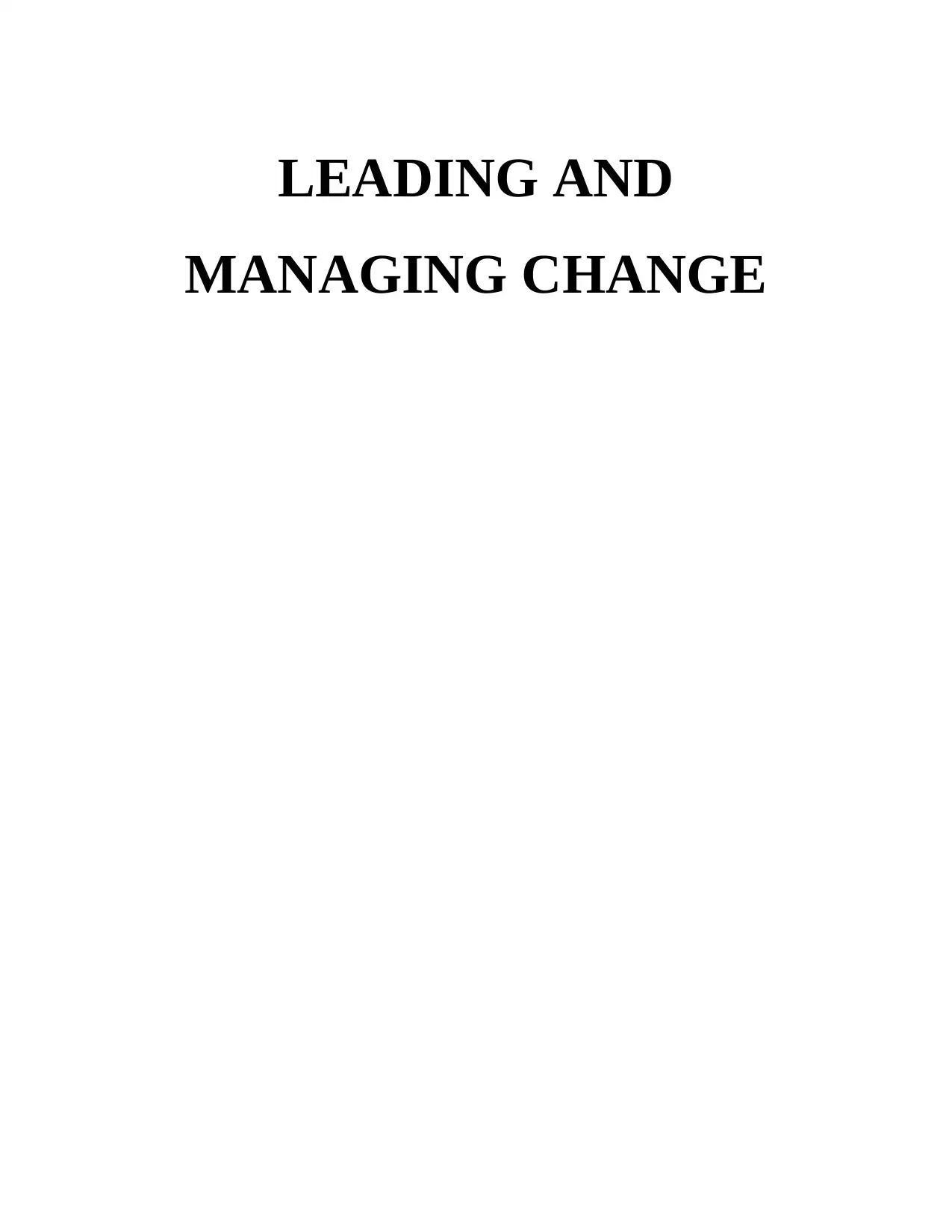
LEADING AND
MANAGING CHANGE
MANAGING CHANGE
Paraphrase This Document
Need a fresh take? Get an instant paraphrase of this document with our AI Paraphraser
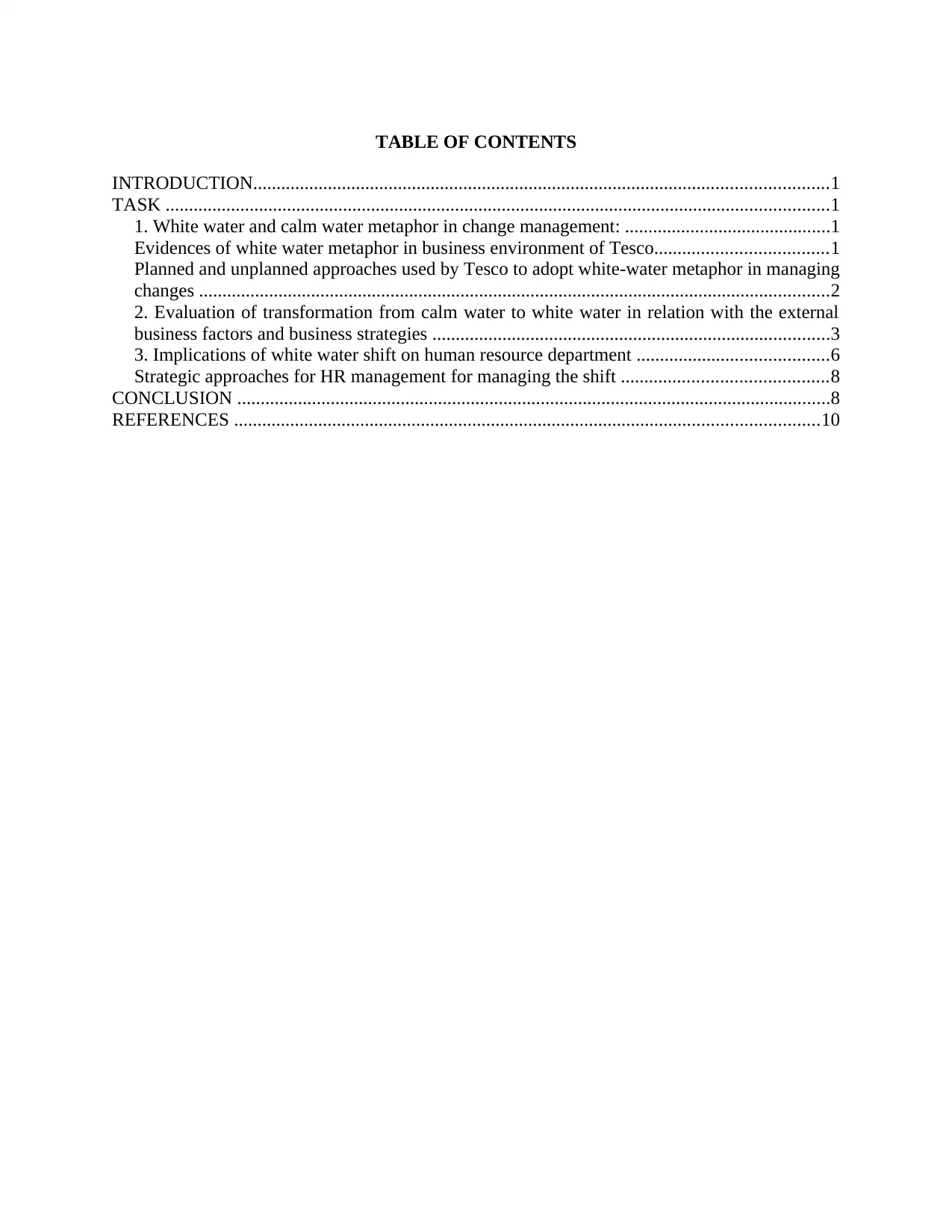
TABLE OF CONTENTS
INTRODUCTION...........................................................................................................................1
TASK ..............................................................................................................................................1
1. White water and calm water metaphor in change management: ............................................1
Evidences of white water metaphor in business environment of Tesco.....................................1
Planned and unplanned approaches used by Tesco to adopt white-water metaphor in managing
changes .......................................................................................................................................2
2. Evaluation of transformation from calm water to white water in relation with the external
business factors and business strategies .....................................................................................3
3. Implications of white water shift on human resource department .........................................6
Strategic approaches for HR management for managing the shift ............................................8
CONCLUSION ...............................................................................................................................8
REFERENCES .............................................................................................................................10
INTRODUCTION...........................................................................................................................1
TASK ..............................................................................................................................................1
1. White water and calm water metaphor in change management: ............................................1
Evidences of white water metaphor in business environment of Tesco.....................................1
Planned and unplanned approaches used by Tesco to adopt white-water metaphor in managing
changes .......................................................................................................................................2
2. Evaluation of transformation from calm water to white water in relation with the external
business factors and business strategies .....................................................................................3
3. Implications of white water shift on human resource department .........................................6
Strategic approaches for HR management for managing the shift ............................................8
CONCLUSION ...............................................................................................................................8
REFERENCES .............................................................................................................................10
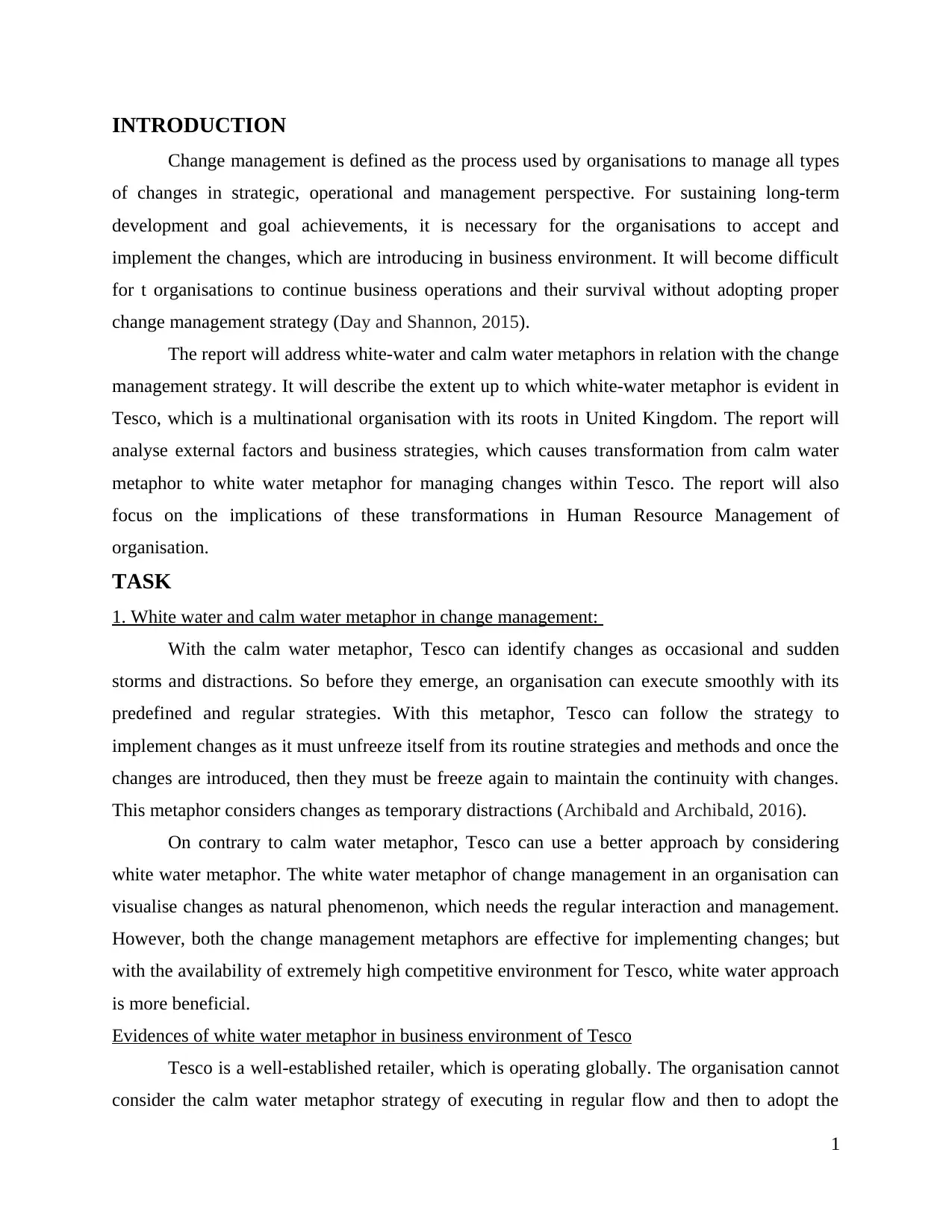
INTRODUCTION
Change management is defined as the process used by organisations to manage all types
of changes in strategic, operational and management perspective. For sustaining long-term
development and goal achievements, it is necessary for the organisations to accept and
implement the changes, which are introducing in business environment. It will become difficult
for t organisations to continue business operations and their survival without adopting proper
change management strategy (Day and Shannon, 2015).
The report will address white-water and calm water metaphors in relation with the change
management strategy. It will describe the extent up to which white-water metaphor is evident in
Tesco, which is a multinational organisation with its roots in United Kingdom. The report will
analyse external factors and business strategies, which causes transformation from calm water
metaphor to white water metaphor for managing changes within Tesco. The report will also
focus on the implications of these transformations in Human Resource Management of
organisation.
TASK
1. White water and calm water metaphor in change management:
With the calm water metaphor, Tesco can identify changes as occasional and sudden
storms and distractions. So before they emerge, an organisation can execute smoothly with its
predefined and regular strategies. With this metaphor, Tesco can follow the strategy to
implement changes as it must unfreeze itself from its routine strategies and methods and once the
changes are introduced, then they must be freeze again to maintain the continuity with changes.
This metaphor considers changes as temporary distractions (Archibald and Archibald, 2016).
On contrary to calm water metaphor, Tesco can use a better approach by considering
white water metaphor. The white water metaphor of change management in an organisation can
visualise changes as natural phenomenon, which needs the regular interaction and management.
However, both the change management metaphors are effective for implementing changes; but
with the availability of extremely high competitive environment for Tesco, white water approach
is more beneficial.
Evidences of white water metaphor in business environment of Tesco
Tesco is a well-established retailer, which is operating globally. The organisation cannot
consider the calm water metaphor strategy of executing in regular flow and then to adopt the
1
Change management is defined as the process used by organisations to manage all types
of changes in strategic, operational and management perspective. For sustaining long-term
development and goal achievements, it is necessary for the organisations to accept and
implement the changes, which are introducing in business environment. It will become difficult
for t organisations to continue business operations and their survival without adopting proper
change management strategy (Day and Shannon, 2015).
The report will address white-water and calm water metaphors in relation with the change
management strategy. It will describe the extent up to which white-water metaphor is evident in
Tesco, which is a multinational organisation with its roots in United Kingdom. The report will
analyse external factors and business strategies, which causes transformation from calm water
metaphor to white water metaphor for managing changes within Tesco. The report will also
focus on the implications of these transformations in Human Resource Management of
organisation.
TASK
1. White water and calm water metaphor in change management:
With the calm water metaphor, Tesco can identify changes as occasional and sudden
storms and distractions. So before they emerge, an organisation can execute smoothly with its
predefined and regular strategies. With this metaphor, Tesco can follow the strategy to
implement changes as it must unfreeze itself from its routine strategies and methods and once the
changes are introduced, then they must be freeze again to maintain the continuity with changes.
This metaphor considers changes as temporary distractions (Archibald and Archibald, 2016).
On contrary to calm water metaphor, Tesco can use a better approach by considering
white water metaphor. The white water metaphor of change management in an organisation can
visualise changes as natural phenomenon, which needs the regular interaction and management.
However, both the change management metaphors are effective for implementing changes; but
with the availability of extremely high competitive environment for Tesco, white water approach
is more beneficial.
Evidences of white water metaphor in business environment of Tesco
Tesco is a well-established retailer, which is operating globally. The organisation cannot
consider the calm water metaphor strategy of executing in regular flow and then to adopt the
1
⊘ This is a preview!⊘
Do you want full access?
Subscribe today to unlock all pages.

Trusted by 1+ million students worldwide
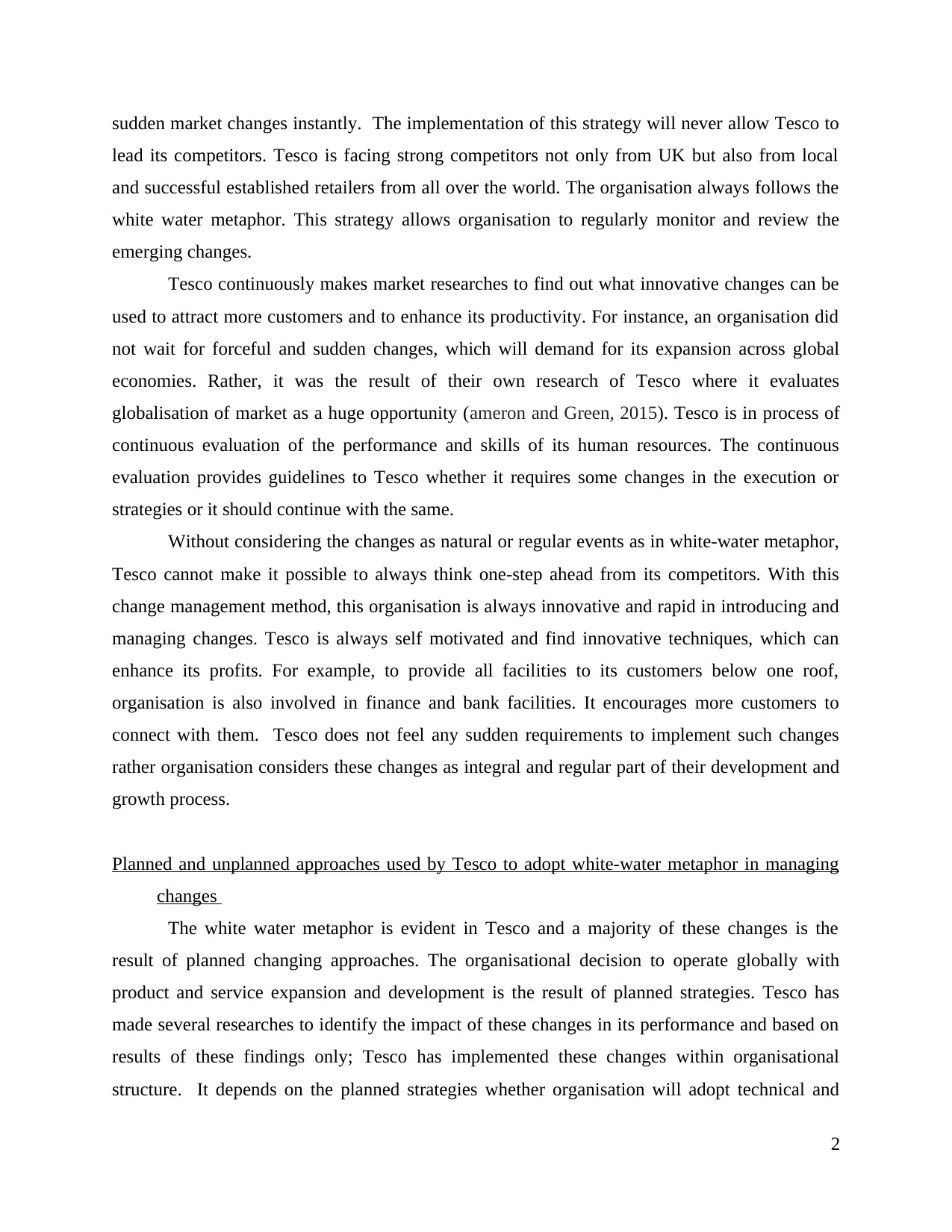
sudden market changes instantly. The implementation of this strategy will never allow Tesco to
lead its competitors. Tesco is facing strong competitors not only from UK but also from local
and successful established retailers from all over the world. The organisation always follows the
white water metaphor. This strategy allows organisation to regularly monitor and review the
emerging changes.
Tesco continuously makes market researches to find out what innovative changes can be
used to attract more customers and to enhance its productivity. For instance, an organisation did
not wait for forceful and sudden changes, which will demand for its expansion across global
economies. Rather, it was the result of their own research of Tesco where it evaluates
globalisation of market as a huge opportunity (ameron and Green, 2015). Tesco is in process of
continuous evaluation of the performance and skills of its human resources. The continuous
evaluation provides guidelines to Tesco whether it requires some changes in the execution or
strategies or it should continue with the same.
Without considering the changes as natural or regular events as in white-water metaphor,
Tesco cannot make it possible to always think one-step ahead from its competitors. With this
change management method, this organisation is always innovative and rapid in introducing and
managing changes. Tesco is always self motivated and find innovative techniques, which can
enhance its profits. For example, to provide all facilities to its customers below one roof,
organisation is also involved in finance and bank facilities. It encourages more customers to
connect with them. Tesco does not feel any sudden requirements to implement such changes
rather organisation considers these changes as integral and regular part of their development and
growth process.
Planned and unplanned approaches used by Tesco to adopt white-water metaphor in managing
changes
The white water metaphor is evident in Tesco and a majority of these changes is the
result of planned changing approaches. The organisational decision to operate globally with
product and service expansion and development is the result of planned strategies. Tesco has
made several researches to identify the impact of these changes in its performance and based on
results of these findings only; Tesco has implemented these changes within organisational
structure. It depends on the planned strategies whether organisation will adopt technical and
2
lead its competitors. Tesco is facing strong competitors not only from UK but also from local
and successful established retailers from all over the world. The organisation always follows the
white water metaphor. This strategy allows organisation to regularly monitor and review the
emerging changes.
Tesco continuously makes market researches to find out what innovative changes can be
used to attract more customers and to enhance its productivity. For instance, an organisation did
not wait for forceful and sudden changes, which will demand for its expansion across global
economies. Rather, it was the result of their own research of Tesco where it evaluates
globalisation of market as a huge opportunity (ameron and Green, 2015). Tesco is in process of
continuous evaluation of the performance and skills of its human resources. The continuous
evaluation provides guidelines to Tesco whether it requires some changes in the execution or
strategies or it should continue with the same.
Without considering the changes as natural or regular events as in white-water metaphor,
Tesco cannot make it possible to always think one-step ahead from its competitors. With this
change management method, this organisation is always innovative and rapid in introducing and
managing changes. Tesco is always self motivated and find innovative techniques, which can
enhance its profits. For example, to provide all facilities to its customers below one roof,
organisation is also involved in finance and bank facilities. It encourages more customers to
connect with them. Tesco does not feel any sudden requirements to implement such changes
rather organisation considers these changes as integral and regular part of their development and
growth process.
Planned and unplanned approaches used by Tesco to adopt white-water metaphor in managing
changes
The white water metaphor is evident in Tesco and a majority of these changes is the
result of planned changing approaches. The organisational decision to operate globally with
product and service expansion and development is the result of planned strategies. Tesco has
made several researches to identify the impact of these changes in its performance and based on
results of these findings only; Tesco has implemented these changes within organisational
structure. It depends on the planned strategies whether organisation will adopt technical and
2
Paraphrase This Document
Need a fresh take? Get an instant paraphrase of this document with our AI Paraphraser
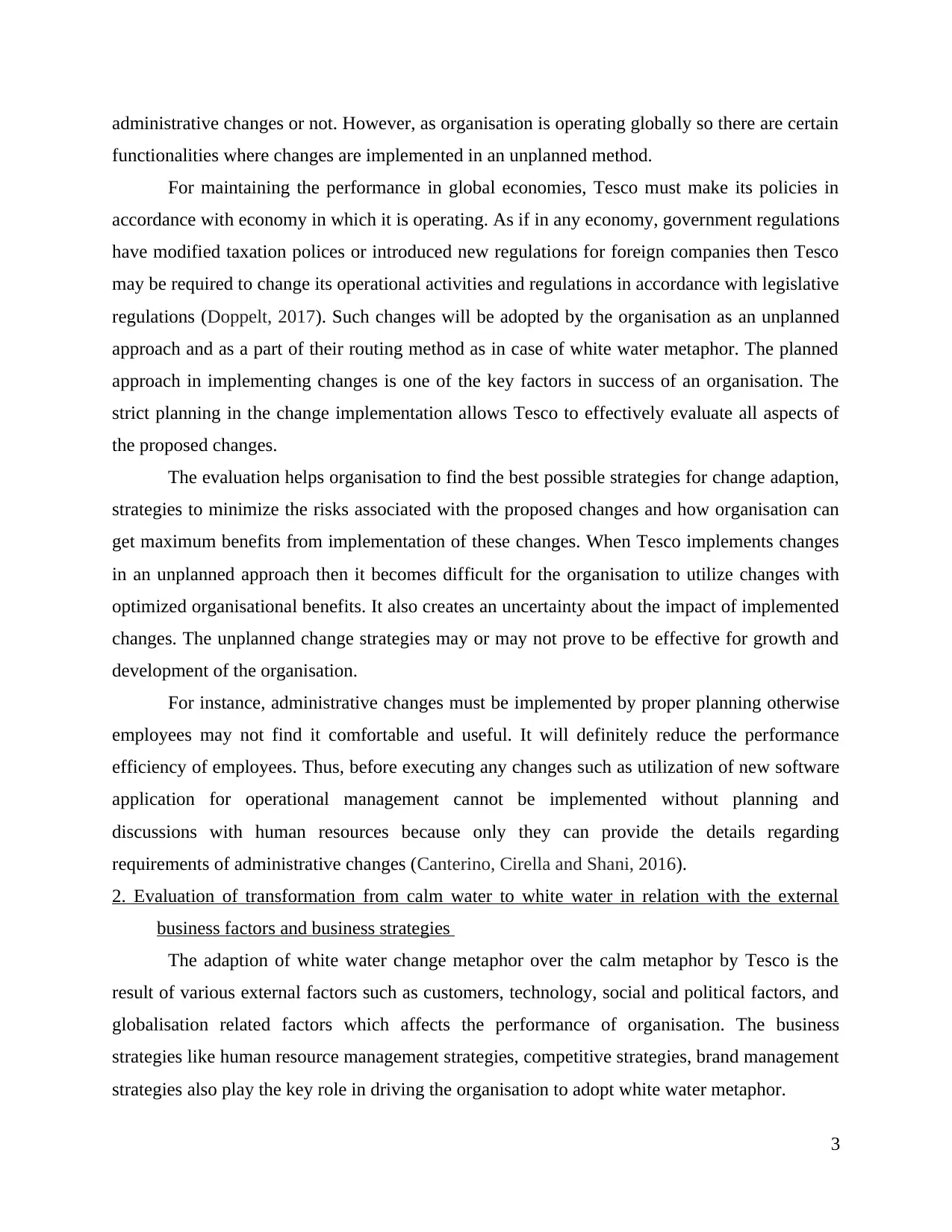
administrative changes or not. However, as organisation is operating globally so there are certain
functionalities where changes are implemented in an unplanned method.
For maintaining the performance in global economies, Tesco must make its policies in
accordance with economy in which it is operating. As if in any economy, government regulations
have modified taxation polices or introduced new regulations for foreign companies then Tesco
may be required to change its operational activities and regulations in accordance with legislative
regulations (Doppelt, 2017). Such changes will be adopted by the organisation as an unplanned
approach and as a part of their routing method as in case of white water metaphor. The planned
approach in implementing changes is one of the key factors in success of an organisation. The
strict planning in the change implementation allows Tesco to effectively evaluate all aspects of
the proposed changes.
The evaluation helps organisation to find the best possible strategies for change adaption,
strategies to minimize the risks associated with the proposed changes and how organisation can
get maximum benefits from implementation of these changes. When Tesco implements changes
in an unplanned approach then it becomes difficult for the organisation to utilize changes with
optimized organisational benefits. It also creates an uncertainty about the impact of implemented
changes. The unplanned change strategies may or may not prove to be effective for growth and
development of the organisation.
For instance, administrative changes must be implemented by proper planning otherwise
employees may not find it comfortable and useful. It will definitely reduce the performance
efficiency of employees. Thus, before executing any changes such as utilization of new software
application for operational management cannot be implemented without planning and
discussions with human resources because only they can provide the details regarding
requirements of administrative changes (Canterino, Cirella and Shani, 2016).
2. Evaluation of transformation from calm water to white water in relation with the external
business factors and business strategies
The adaption of white water change metaphor over the calm metaphor by Tesco is the
result of various external factors such as customers, technology, social and political factors, and
globalisation related factors which affects the performance of organisation. The business
strategies like human resource management strategies, competitive strategies, brand management
strategies also play the key role in driving the organisation to adopt white water metaphor.
3
functionalities where changes are implemented in an unplanned method.
For maintaining the performance in global economies, Tesco must make its policies in
accordance with economy in which it is operating. As if in any economy, government regulations
have modified taxation polices or introduced new regulations for foreign companies then Tesco
may be required to change its operational activities and regulations in accordance with legislative
regulations (Doppelt, 2017). Such changes will be adopted by the organisation as an unplanned
approach and as a part of their routing method as in case of white water metaphor. The planned
approach in implementing changes is one of the key factors in success of an organisation. The
strict planning in the change implementation allows Tesco to effectively evaluate all aspects of
the proposed changes.
The evaluation helps organisation to find the best possible strategies for change adaption,
strategies to minimize the risks associated with the proposed changes and how organisation can
get maximum benefits from implementation of these changes. When Tesco implements changes
in an unplanned approach then it becomes difficult for the organisation to utilize changes with
optimized organisational benefits. It also creates an uncertainty about the impact of implemented
changes. The unplanned change strategies may or may not prove to be effective for growth and
development of the organisation.
For instance, administrative changes must be implemented by proper planning otherwise
employees may not find it comfortable and useful. It will definitely reduce the performance
efficiency of employees. Thus, before executing any changes such as utilization of new software
application for operational management cannot be implemented without planning and
discussions with human resources because only they can provide the details regarding
requirements of administrative changes (Canterino, Cirella and Shani, 2016).
2. Evaluation of transformation from calm water to white water in relation with the external
business factors and business strategies
The adaption of white water change metaphor over the calm metaphor by Tesco is the
result of various external factors such as customers, technology, social and political factors, and
globalisation related factors which affects the performance of organisation. The business
strategies like human resource management strategies, competitive strategies, brand management
strategies also play the key role in driving the organisation to adopt white water metaphor.
3
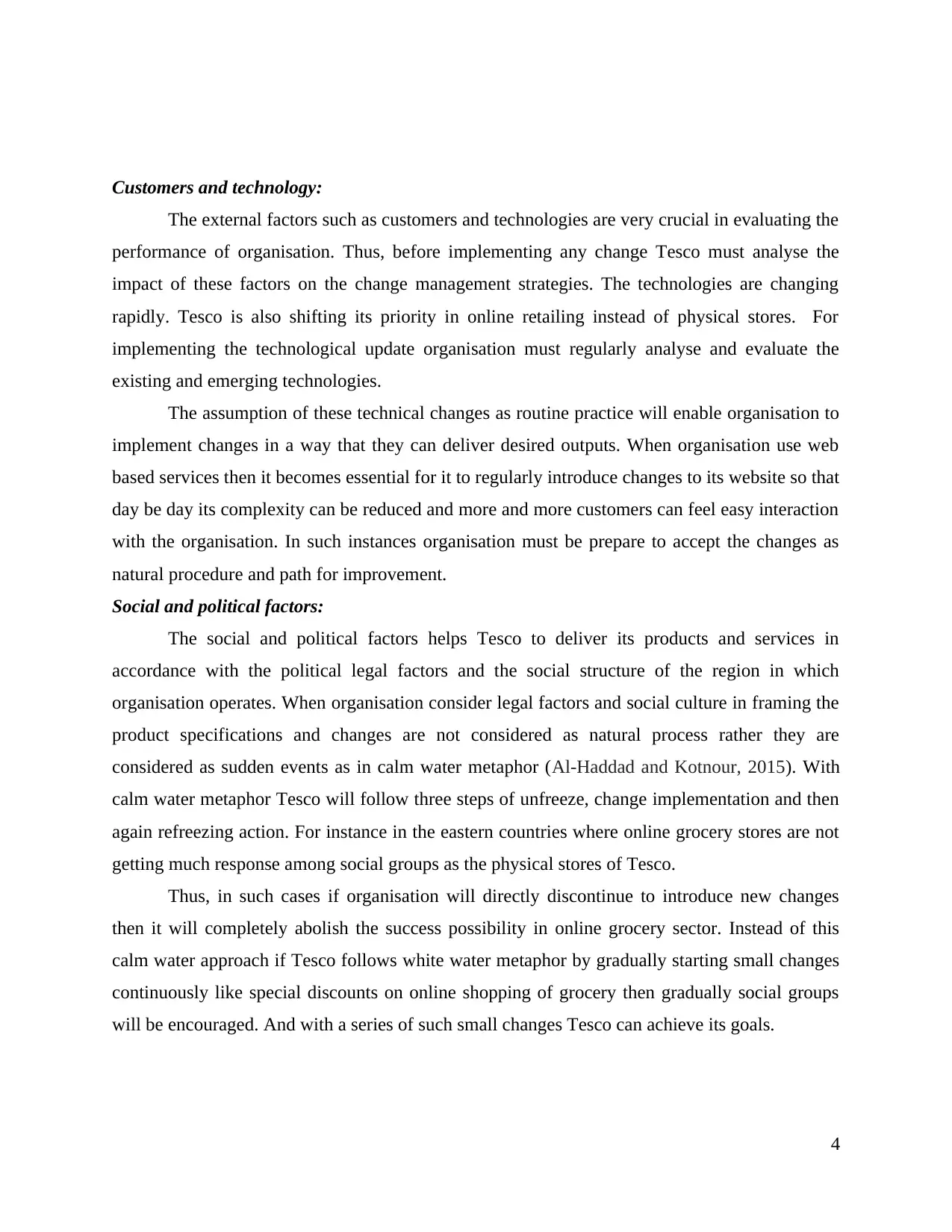
Customers and technology:
The external factors such as customers and technologies are very crucial in evaluating the
performance of organisation. Thus, before implementing any change Tesco must analyse the
impact of these factors on the change management strategies. The technologies are changing
rapidly. Tesco is also shifting its priority in online retailing instead of physical stores. For
implementing the technological update organisation must regularly analyse and evaluate the
existing and emerging technologies.
The assumption of these technical changes as routine practice will enable organisation to
implement changes in a way that they can deliver desired outputs. When organisation use web
based services then it becomes essential for it to regularly introduce changes to its website so that
day be day its complexity can be reduced and more and more customers can feel easy interaction
with the organisation. In such instances organisation must be prepare to accept the changes as
natural procedure and path for improvement.
Social and political factors:
The social and political factors helps Tesco to deliver its products and services in
accordance with the political legal factors and the social structure of the region in which
organisation operates. When organisation consider legal factors and social culture in framing the
product specifications and changes are not considered as natural process rather they are
considered as sudden events as in calm water metaphor (Al-Haddad and Kotnour, 2015). With
calm water metaphor Tesco will follow three steps of unfreeze, change implementation and then
again refreezing action. For instance in the eastern countries where online grocery stores are not
getting much response among social groups as the physical stores of Tesco.
Thus, in such cases if organisation will directly discontinue to introduce new changes
then it will completely abolish the success possibility in online grocery sector. Instead of this
calm water approach if Tesco follows white water metaphor by gradually starting small changes
continuously like special discounts on online shopping of grocery then gradually social groups
will be encouraged. And with a series of such small changes Tesco can achieve its goals.
4
The external factors such as customers and technologies are very crucial in evaluating the
performance of organisation. Thus, before implementing any change Tesco must analyse the
impact of these factors on the change management strategies. The technologies are changing
rapidly. Tesco is also shifting its priority in online retailing instead of physical stores. For
implementing the technological update organisation must regularly analyse and evaluate the
existing and emerging technologies.
The assumption of these technical changes as routine practice will enable organisation to
implement changes in a way that they can deliver desired outputs. When organisation use web
based services then it becomes essential for it to regularly introduce changes to its website so that
day be day its complexity can be reduced and more and more customers can feel easy interaction
with the organisation. In such instances organisation must be prepare to accept the changes as
natural procedure and path for improvement.
Social and political factors:
The social and political factors helps Tesco to deliver its products and services in
accordance with the political legal factors and the social structure of the region in which
organisation operates. When organisation consider legal factors and social culture in framing the
product specifications and changes are not considered as natural process rather they are
considered as sudden events as in calm water metaphor (Al-Haddad and Kotnour, 2015). With
calm water metaphor Tesco will follow three steps of unfreeze, change implementation and then
again refreezing action. For instance in the eastern countries where online grocery stores are not
getting much response among social groups as the physical stores of Tesco.
Thus, in such cases if organisation will directly discontinue to introduce new changes
then it will completely abolish the success possibility in online grocery sector. Instead of this
calm water approach if Tesco follows white water metaphor by gradually starting small changes
continuously like special discounts on online shopping of grocery then gradually social groups
will be encouraged. And with a series of such small changes Tesco can achieve its goals.
4
⊘ This is a preview!⊘
Do you want full access?
Subscribe today to unlock all pages.

Trusted by 1+ million students worldwide
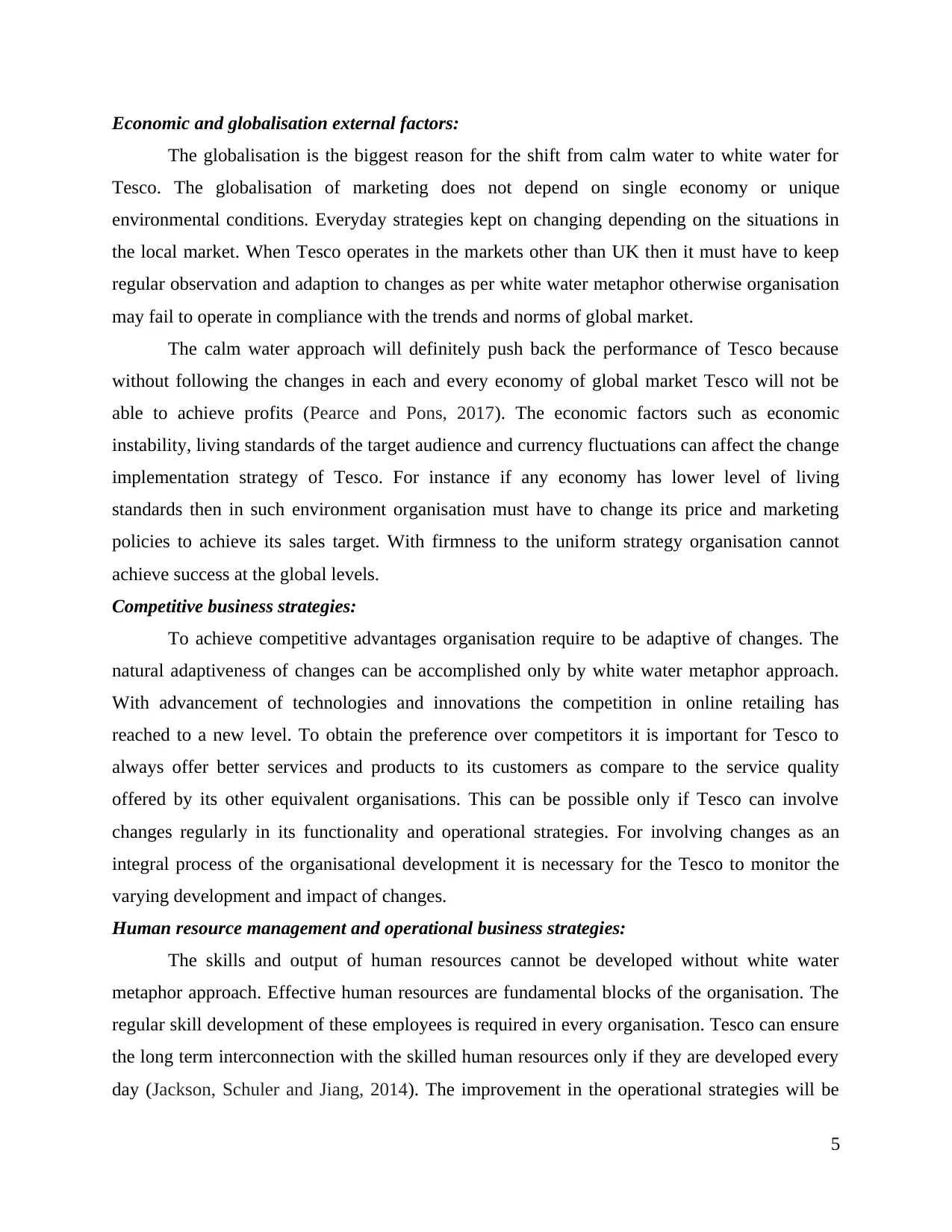
Economic and globalisation external factors:
The globalisation is the biggest reason for the shift from calm water to white water for
Tesco. The globalisation of marketing does not depend on single economy or unique
environmental conditions. Everyday strategies kept on changing depending on the situations in
the local market. When Tesco operates in the markets other than UK then it must have to keep
regular observation and adaption to changes as per white water metaphor otherwise organisation
may fail to operate in compliance with the trends and norms of global market.
The calm water approach will definitely push back the performance of Tesco because
without following the changes in each and every economy of global market Tesco will not be
able to achieve profits (Pearce and Pons, 2017). The economic factors such as economic
instability, living standards of the target audience and currency fluctuations can affect the change
implementation strategy of Tesco. For instance if any economy has lower level of living
standards then in such environment organisation must have to change its price and marketing
policies to achieve its sales target. With firmness to the uniform strategy organisation cannot
achieve success at the global levels.
Competitive business strategies:
To achieve competitive advantages organisation require to be adaptive of changes. The
natural adaptiveness of changes can be accomplished only by white water metaphor approach.
With advancement of technologies and innovations the competition in online retailing has
reached to a new level. To obtain the preference over competitors it is important for Tesco to
always offer better services and products to its customers as compare to the service quality
offered by its other equivalent organisations. This can be possible only if Tesco can involve
changes regularly in its functionality and operational strategies. For involving changes as an
integral process of the organisational development it is necessary for the Tesco to monitor the
varying development and impact of changes.
Human resource management and operational business strategies:
The skills and output of human resources cannot be developed without white water
metaphor approach. Effective human resources are fundamental blocks of the organisation. The
regular skill development of these employees is required in every organisation. Tesco can ensure
the long term interconnection with the skilled human resources only if they are developed every
day (Jackson, Schuler and Jiang, 2014). The improvement in the operational strategies will be
5
The globalisation is the biggest reason for the shift from calm water to white water for
Tesco. The globalisation of marketing does not depend on single economy or unique
environmental conditions. Everyday strategies kept on changing depending on the situations in
the local market. When Tesco operates in the markets other than UK then it must have to keep
regular observation and adaption to changes as per white water metaphor otherwise organisation
may fail to operate in compliance with the trends and norms of global market.
The calm water approach will definitely push back the performance of Tesco because
without following the changes in each and every economy of global market Tesco will not be
able to achieve profits (Pearce and Pons, 2017). The economic factors such as economic
instability, living standards of the target audience and currency fluctuations can affect the change
implementation strategy of Tesco. For instance if any economy has lower level of living
standards then in such environment organisation must have to change its price and marketing
policies to achieve its sales target. With firmness to the uniform strategy organisation cannot
achieve success at the global levels.
Competitive business strategies:
To achieve competitive advantages organisation require to be adaptive of changes. The
natural adaptiveness of changes can be accomplished only by white water metaphor approach.
With advancement of technologies and innovations the competition in online retailing has
reached to a new level. To obtain the preference over competitors it is important for Tesco to
always offer better services and products to its customers as compare to the service quality
offered by its other equivalent organisations. This can be possible only if Tesco can involve
changes regularly in its functionality and operational strategies. For involving changes as an
integral process of the organisational development it is necessary for the Tesco to monitor the
varying development and impact of changes.
Human resource management and operational business strategies:
The skills and output of human resources cannot be developed without white water
metaphor approach. Effective human resources are fundamental blocks of the organisation. The
regular skill development of these employees is required in every organisation. Tesco can ensure
the long term interconnection with the skilled human resources only if they are developed every
day (Jackson, Schuler and Jiang, 2014). The improvement in the operational strategies will be
5
Paraphrase This Document
Need a fresh take? Get an instant paraphrase of this document with our AI Paraphraser
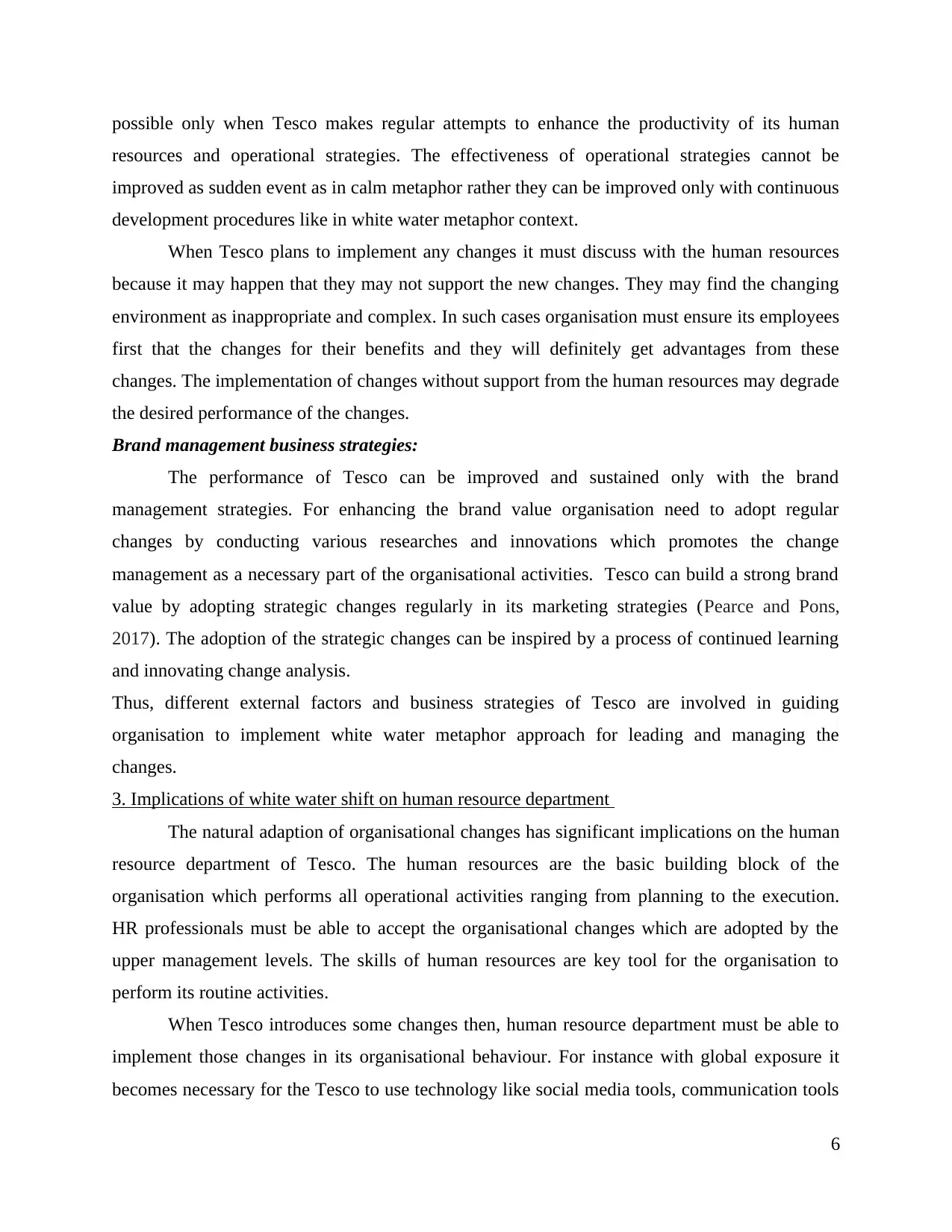
possible only when Tesco makes regular attempts to enhance the productivity of its human
resources and operational strategies. The effectiveness of operational strategies cannot be
improved as sudden event as in calm metaphor rather they can be improved only with continuous
development procedures like in white water metaphor context.
When Tesco plans to implement any changes it must discuss with the human resources
because it may happen that they may not support the new changes. They may find the changing
environment as inappropriate and complex. In such cases organisation must ensure its employees
first that the changes for their benefits and they will definitely get advantages from these
changes. The implementation of changes without support from the human resources may degrade
the desired performance of the changes.
Brand management business strategies:
The performance of Tesco can be improved and sustained only with the brand
management strategies. For enhancing the brand value organisation need to adopt regular
changes by conducting various researches and innovations which promotes the change
management as a necessary part of the organisational activities. Tesco can build a strong brand
value by adopting strategic changes regularly in its marketing strategies (Pearce and Pons,
2017). The adoption of the strategic changes can be inspired by a process of continued learning
and innovating change analysis.
Thus, different external factors and business strategies of Tesco are involved in guiding
organisation to implement white water metaphor approach for leading and managing the
changes.
3. Implications of white water shift on human resource department
The natural adaption of organisational changes has significant implications on the human
resource department of Tesco. The human resources are the basic building block of the
organisation which performs all operational activities ranging from planning to the execution.
HR professionals must be able to accept the organisational changes which are adopted by the
upper management levels. The skills of human resources are key tool for the organisation to
perform its routine activities.
When Tesco introduces some changes then, human resource department must be able to
implement those changes in its organisational behaviour. For instance with global exposure it
becomes necessary for the Tesco to use technology like social media tools, communication tools
6
resources and operational strategies. The effectiveness of operational strategies cannot be
improved as sudden event as in calm metaphor rather they can be improved only with continuous
development procedures like in white water metaphor context.
When Tesco plans to implement any changes it must discuss with the human resources
because it may happen that they may not support the new changes. They may find the changing
environment as inappropriate and complex. In such cases organisation must ensure its employees
first that the changes for their benefits and they will definitely get advantages from these
changes. The implementation of changes without support from the human resources may degrade
the desired performance of the changes.
Brand management business strategies:
The performance of Tesco can be improved and sustained only with the brand
management strategies. For enhancing the brand value organisation need to adopt regular
changes by conducting various researches and innovations which promotes the change
management as a necessary part of the organisational activities. Tesco can build a strong brand
value by adopting strategic changes regularly in its marketing strategies (Pearce and Pons,
2017). The adoption of the strategic changes can be inspired by a process of continued learning
and innovating change analysis.
Thus, different external factors and business strategies of Tesco are involved in guiding
organisation to implement white water metaphor approach for leading and managing the
changes.
3. Implications of white water shift on human resource department
The natural adaption of organisational changes has significant implications on the human
resource department of Tesco. The human resources are the basic building block of the
organisation which performs all operational activities ranging from planning to the execution.
HR professionals must be able to accept the organisational changes which are adopted by the
upper management levels. The skills of human resources are key tool for the organisation to
perform its routine activities.
When Tesco introduces some changes then, human resource department must be able to
implement those changes in its organisational behaviour. For instance with global exposure it
becomes necessary for the Tesco to use technology like social media tools, communication tools
6
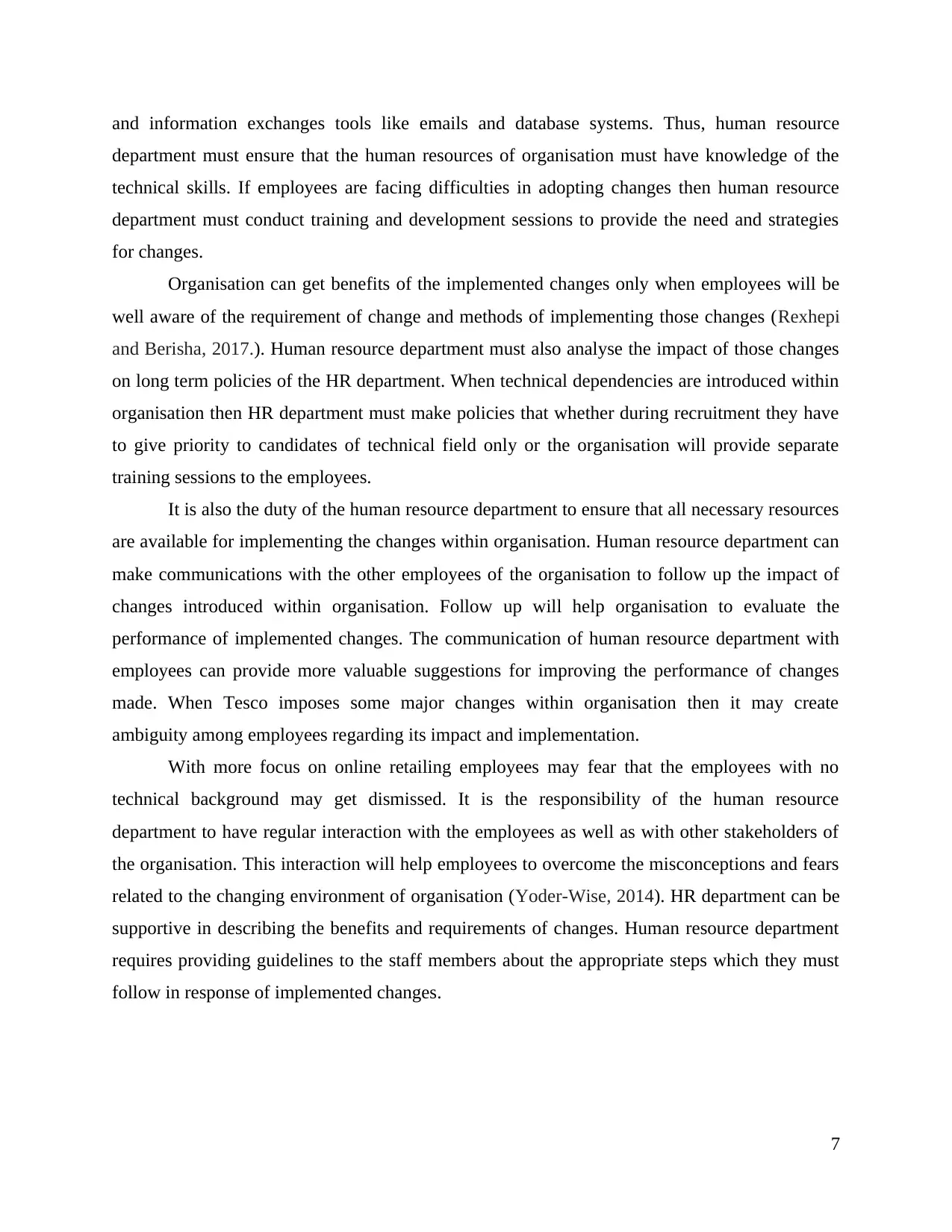
and information exchanges tools like emails and database systems. Thus, human resource
department must ensure that the human resources of organisation must have knowledge of the
technical skills. If employees are facing difficulties in adopting changes then human resource
department must conduct training and development sessions to provide the need and strategies
for changes.
Organisation can get benefits of the implemented changes only when employees will be
well aware of the requirement of change and methods of implementing those changes (Rexhepi
and Berisha, 2017.). Human resource department must also analyse the impact of those changes
on long term policies of the HR department. When technical dependencies are introduced within
organisation then HR department must make policies that whether during recruitment they have
to give priority to candidates of technical field only or the organisation will provide separate
training sessions to the employees.
It is also the duty of the human resource department to ensure that all necessary resources
are available for implementing the changes within organisation. Human resource department can
make communications with the other employees of the organisation to follow up the impact of
changes introduced within organisation. Follow up will help organisation to evaluate the
performance of implemented changes. The communication of human resource department with
employees can provide more valuable suggestions for improving the performance of changes
made. When Tesco imposes some major changes within organisation then it may create
ambiguity among employees regarding its impact and implementation.
With more focus on online retailing employees may fear that the employees with no
technical background may get dismissed. It is the responsibility of the human resource
department to have regular interaction with the employees as well as with other stakeholders of
the organisation. This interaction will help employees to overcome the misconceptions and fears
related to the changing environment of organisation (Yoder-Wise, 2014). HR department can be
supportive in describing the benefits and requirements of changes. Human resource department
requires providing guidelines to the staff members about the appropriate steps which they must
follow in response of implemented changes.
7
department must ensure that the human resources of organisation must have knowledge of the
technical skills. If employees are facing difficulties in adopting changes then human resource
department must conduct training and development sessions to provide the need and strategies
for changes.
Organisation can get benefits of the implemented changes only when employees will be
well aware of the requirement of change and methods of implementing those changes (Rexhepi
and Berisha, 2017.). Human resource department must also analyse the impact of those changes
on long term policies of the HR department. When technical dependencies are introduced within
organisation then HR department must make policies that whether during recruitment they have
to give priority to candidates of technical field only or the organisation will provide separate
training sessions to the employees.
It is also the duty of the human resource department to ensure that all necessary resources
are available for implementing the changes within organisation. Human resource department can
make communications with the other employees of the organisation to follow up the impact of
changes introduced within organisation. Follow up will help organisation to evaluate the
performance of implemented changes. The communication of human resource department with
employees can provide more valuable suggestions for improving the performance of changes
made. When Tesco imposes some major changes within organisation then it may create
ambiguity among employees regarding its impact and implementation.
With more focus on online retailing employees may fear that the employees with no
technical background may get dismissed. It is the responsibility of the human resource
department to have regular interaction with the employees as well as with other stakeholders of
the organisation. This interaction will help employees to overcome the misconceptions and fears
related to the changing environment of organisation (Yoder-Wise, 2014). HR department can be
supportive in describing the benefits and requirements of changes. Human resource department
requires providing guidelines to the staff members about the appropriate steps which they must
follow in response of implemented changes.
7
⊘ This is a preview!⊘
Do you want full access?
Subscribe today to unlock all pages.

Trusted by 1+ million students worldwide
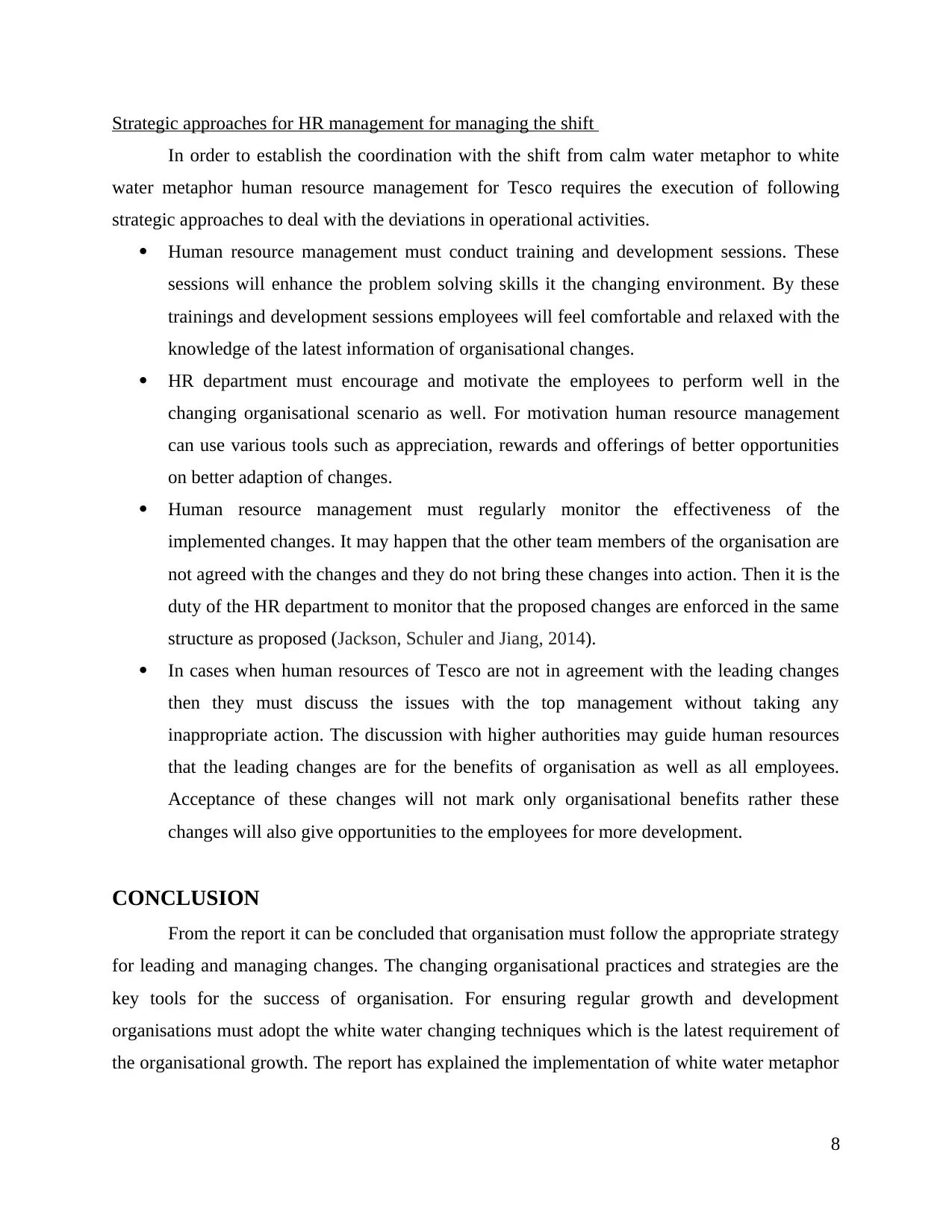
Strategic approaches for HR management for managing the shift
In order to establish the coordination with the shift from calm water metaphor to white
water metaphor human resource management for Tesco requires the execution of following
strategic approaches to deal with the deviations in operational activities.
Human resource management must conduct training and development sessions. These
sessions will enhance the problem solving skills it the changing environment. By these
trainings and development sessions employees will feel comfortable and relaxed with the
knowledge of the latest information of organisational changes.
HR department must encourage and motivate the employees to perform well in the
changing organisational scenario as well. For motivation human resource management
can use various tools such as appreciation, rewards and offerings of better opportunities
on better adaption of changes.
Human resource management must regularly monitor the effectiveness of the
implemented changes. It may happen that the other team members of the organisation are
not agreed with the changes and they do not bring these changes into action. Then it is the
duty of the HR department to monitor that the proposed changes are enforced in the same
structure as proposed (Jackson, Schuler and Jiang, 2014).
In cases when human resources of Tesco are not in agreement with the leading changes
then they must discuss the issues with the top management without taking any
inappropriate action. The discussion with higher authorities may guide human resources
that the leading changes are for the benefits of organisation as well as all employees.
Acceptance of these changes will not mark only organisational benefits rather these
changes will also give opportunities to the employees for more development.
CONCLUSION
From the report it can be concluded that organisation must follow the appropriate strategy
for leading and managing changes. The changing organisational practices and strategies are the
key tools for the success of organisation. For ensuring regular growth and development
organisations must adopt the white water changing techniques which is the latest requirement of
the organisational growth. The report has explained the implementation of white water metaphor
8
In order to establish the coordination with the shift from calm water metaphor to white
water metaphor human resource management for Tesco requires the execution of following
strategic approaches to deal with the deviations in operational activities.
Human resource management must conduct training and development sessions. These
sessions will enhance the problem solving skills it the changing environment. By these
trainings and development sessions employees will feel comfortable and relaxed with the
knowledge of the latest information of organisational changes.
HR department must encourage and motivate the employees to perform well in the
changing organisational scenario as well. For motivation human resource management
can use various tools such as appreciation, rewards and offerings of better opportunities
on better adaption of changes.
Human resource management must regularly monitor the effectiveness of the
implemented changes. It may happen that the other team members of the organisation are
not agreed with the changes and they do not bring these changes into action. Then it is the
duty of the HR department to monitor that the proposed changes are enforced in the same
structure as proposed (Jackson, Schuler and Jiang, 2014).
In cases when human resources of Tesco are not in agreement with the leading changes
then they must discuss the issues with the top management without taking any
inappropriate action. The discussion with higher authorities may guide human resources
that the leading changes are for the benefits of organisation as well as all employees.
Acceptance of these changes will not mark only organisational benefits rather these
changes will also give opportunities to the employees for more development.
CONCLUSION
From the report it can be concluded that organisation must follow the appropriate strategy
for leading and managing changes. The changing organisational practices and strategies are the
key tools for the success of organisation. For ensuring regular growth and development
organisations must adopt the white water changing techniques which is the latest requirement of
the organisational growth. The report has explained the implementation of white water metaphor
8
Paraphrase This Document
Need a fresh take? Get an instant paraphrase of this document with our AI Paraphraser
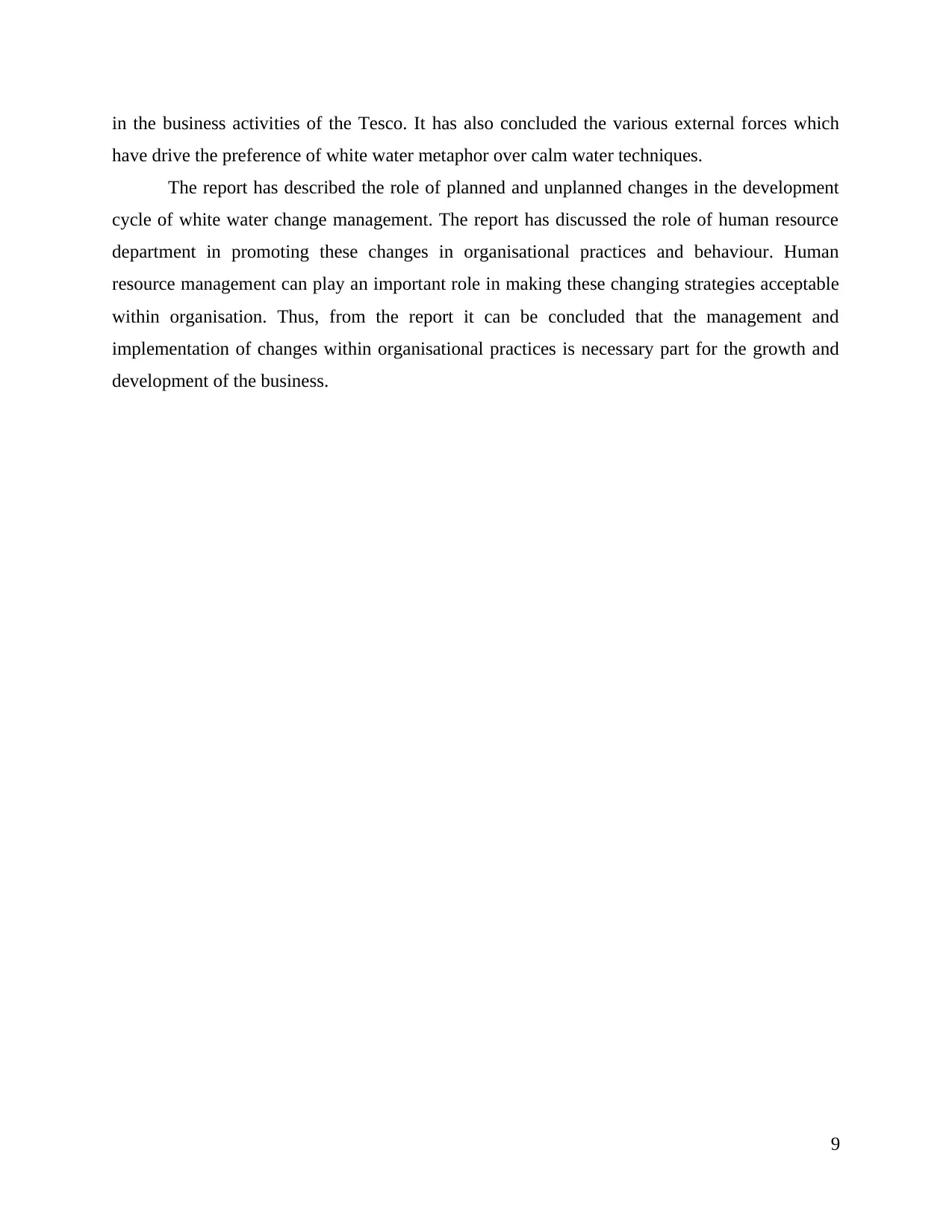
in the business activities of the Tesco. It has also concluded the various external forces which
have drive the preference of white water metaphor over calm water techniques.
The report has described the role of planned and unplanned changes in the development
cycle of white water change management. The report has discussed the role of human resource
department in promoting these changes in organisational practices and behaviour. Human
resource management can play an important role in making these changing strategies acceptable
within organisation. Thus, from the report it can be concluded that the management and
implementation of changes within organisational practices is necessary part for the growth and
development of the business.
9
have drive the preference of white water metaphor over calm water techniques.
The report has described the role of planned and unplanned changes in the development
cycle of white water change management. The report has discussed the role of human resource
department in promoting these changes in organisational practices and behaviour. Human
resource management can play an important role in making these changing strategies acceptable
within organisation. Thus, from the report it can be concluded that the management and
implementation of changes within organisational practices is necessary part for the growth and
development of the business.
9
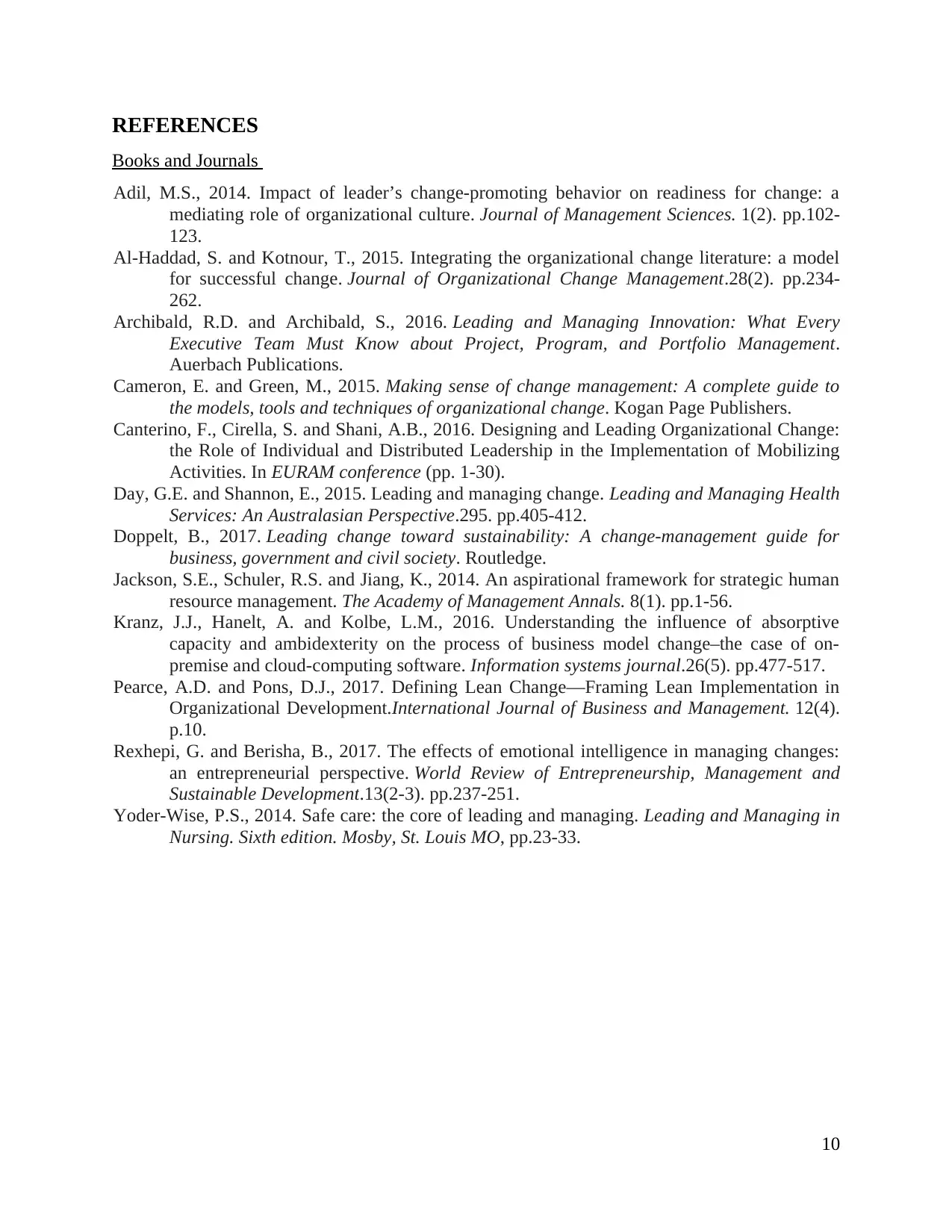
REFERENCES
Books and Journals
Adil, M.S., 2014. Impact of leader’s change-promoting behavior on readiness for change: a
mediating role of organizational culture. Journal of Management Sciences. 1(2). pp.102-
123.
Al-Haddad, S. and Kotnour, T., 2015. Integrating the organizational change literature: a model
for successful change. Journal of Organizational Change Management.28(2). pp.234-
262.
Archibald, R.D. and Archibald, S., 2016. Leading and Managing Innovation: What Every
Executive Team Must Know about Project, Program, and Portfolio Management.
Auerbach Publications.
Cameron, E. and Green, M., 2015. Making sense of change management: A complete guide to
the models, tools and techniques of organizational change. Kogan Page Publishers.
Canterino, F., Cirella, S. and Shani, A.B., 2016. Designing and Leading Organizational Change:
the Role of Individual and Distributed Leadership in the Implementation of Mobilizing
Activities. In EURAM conference (pp. 1-30).
Day, G.E. and Shannon, E., 2015. Leading and managing change. Leading and Managing Health
Services: An Australasian Perspective.295. pp.405-412.
Doppelt, B., 2017. Leading change toward sustainability: A change-management guide for
business, government and civil society. Routledge.
Jackson, S.E., Schuler, R.S. and Jiang, K., 2014. An aspirational framework for strategic human
resource management. The Academy of Management Annals. 8(1). pp.1-56.
Kranz, J.J., Hanelt, A. and Kolbe, L.M., 2016. Understanding the influence of absorptive
capacity and ambidexterity on the process of business model change–the case of on‐
premise and cloud‐computing software. Information systems journal.26(5). pp.477-517.
Pearce, A.D. and Pons, D.J., 2017. Defining Lean Change—Framing Lean Implementation in
Organizational Development.International Journal of Business and Management. 12(4).
p.10.
Rexhepi, G. and Berisha, B., 2017. The effects of emotional intelligence in managing changes:
an entrepreneurial perspective. World Review of Entrepreneurship, Management and
Sustainable Development.13(2-3). pp.237-251.
Yoder-Wise, P.S., 2014. Safe care: the core of leading and managing. Leading and Managing in
Nursing. Sixth edition. Mosby, St. Louis MO, pp.23-33.
10
Books and Journals
Adil, M.S., 2014. Impact of leader’s change-promoting behavior on readiness for change: a
mediating role of organizational culture. Journal of Management Sciences. 1(2). pp.102-
123.
Al-Haddad, S. and Kotnour, T., 2015. Integrating the organizational change literature: a model
for successful change. Journal of Organizational Change Management.28(2). pp.234-
262.
Archibald, R.D. and Archibald, S., 2016. Leading and Managing Innovation: What Every
Executive Team Must Know about Project, Program, and Portfolio Management.
Auerbach Publications.
Cameron, E. and Green, M., 2015. Making sense of change management: A complete guide to
the models, tools and techniques of organizational change. Kogan Page Publishers.
Canterino, F., Cirella, S. and Shani, A.B., 2016. Designing and Leading Organizational Change:
the Role of Individual and Distributed Leadership in the Implementation of Mobilizing
Activities. In EURAM conference (pp. 1-30).
Day, G.E. and Shannon, E., 2015. Leading and managing change. Leading and Managing Health
Services: An Australasian Perspective.295. pp.405-412.
Doppelt, B., 2017. Leading change toward sustainability: A change-management guide for
business, government and civil society. Routledge.
Jackson, S.E., Schuler, R.S. and Jiang, K., 2014. An aspirational framework for strategic human
resource management. The Academy of Management Annals. 8(1). pp.1-56.
Kranz, J.J., Hanelt, A. and Kolbe, L.M., 2016. Understanding the influence of absorptive
capacity and ambidexterity on the process of business model change–the case of on‐
premise and cloud‐computing software. Information systems journal.26(5). pp.477-517.
Pearce, A.D. and Pons, D.J., 2017. Defining Lean Change—Framing Lean Implementation in
Organizational Development.International Journal of Business and Management. 12(4).
p.10.
Rexhepi, G. and Berisha, B., 2017. The effects of emotional intelligence in managing changes:
an entrepreneurial perspective. World Review of Entrepreneurship, Management and
Sustainable Development.13(2-3). pp.237-251.
Yoder-Wise, P.S., 2014. Safe care: the core of leading and managing. Leading and Managing in
Nursing. Sixth edition. Mosby, St. Louis MO, pp.23-33.
10
⊘ This is a preview!⊘
Do you want full access?
Subscribe today to unlock all pages.

Trusted by 1+ million students worldwide
1 out of 12
Related Documents
Your All-in-One AI-Powered Toolkit for Academic Success.
+13062052269
info@desklib.com
Available 24*7 on WhatsApp / Email
![[object Object]](/_next/static/media/star-bottom.7253800d.svg)
Unlock your academic potential
Copyright © 2020–2025 A2Z Services. All Rights Reserved. Developed and managed by ZUCOL.





